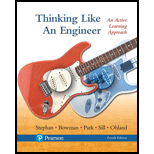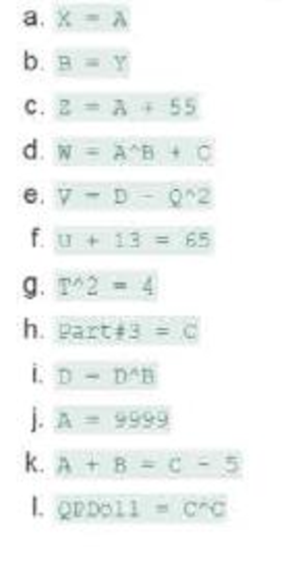
Thinking Like an Engineer: An Active Learning Approach (4th Edition)
4th Edition
ISBN: 9780134639673
Author: Elizabeth A. Stephan, David R. Bowman, William J. Park, Benjamin L. Sill, Matthew W. Ohland
Publisher: PEARSON
expand_more
expand_more
format_list_bulleted
Concept explainers
Textbook Question
Chapter 15.1, Problem 2CC
Which of the following assignment statements are valid? For those that are not valid, explain why. For those that are valid, show what value is placed into which variable. Assume the following variables (and no others) have already been defined: A=2 B=–1 C=3 D=2.5
Note that the priority of operators is the same as in Microsoft Excel.

Expert Solution & Answer
Trending nowThis is a popular solution!

Students have asked these similar questions
(read image)
(read image) Answer Provided
This is part B
Part A's question and answer was find moment of inertia (Ix = 3.90×10^5) and radius of gyration (kx = 21.861)
Determine the centroid ( x & y ) of the I-section, Calculate the moment of inertia of the section about itscentroidal x & y axes. How or why is this result different fromthe result of a previous problem?
Chapter 15 Solutions
Thinking Like an Engineer: An Active Learning Approach (4th Edition)
Ch. 15.1 - Which of the following are valid MATLAB variable...Ch. 15.1 - Which of the following assignment statements are...Ch. 15.1 - a. Store all workspace variables in the file...Ch. 15.2 - Write MATLAB code to complete the following...Ch. 15.2 - a. Calculate the two roots of the quadratic...Ch. 15.3 - Each problem should be done with a single MATLAB...Ch. 15.3 - Assume a row vector named vals has already been...Ch. 15.3 - a. Place the indices of all nonzero elements of...Ch. 15.3 - a. Create a column vector CV1 containing 123...Ch. 15.3 - Comprehension Check 15-1 0 a. Assume you have four...
Ch. 15.3 - a. Write a single MATLAB command that will create...Ch. 15.4 - a. Create the matrix CCM1=[180.34.11017] using a...Ch. 15.4 - Write single MATLAB statements to perform each of...Ch. 15.4 - Write single MATLAB statements to perform each of...Ch. 15.4 - Write single MATLAB statements to perform each of...Ch. 15.4 - Write single MATLAB statements to perform each of...Ch. 15.4 - For each of the following questions, write a...Ch. 15.5 - a. Create a variable named MTS containing the text...Ch. 15.6 - Assume a cell array named CA has three cells in a...Ch. 15.6 - Prob. 21CCCh. 15.7 - Create a structure array named Resistors...Ch. 15.7 - Use the data stored in MetalData to answer the...Ch. 15.7 - The structure array named Hdwr has the following...Ch. 15 - Which of the following are not valid MATLAB...Ch. 15 - Prob. 2ICACh. 15 - For the following questions, assume that the...Ch. 15 - For each calculation described below, write a...Ch. 15 - For each calculation described below, write a...Ch. 15 - For each of the vectors described below, write a...Ch. 15 - Assume the following vectors are already defined:...Ch. 15 - For each of the following sequences, write a...Ch. 15 - Modify the following statements so that they are...Ch. 15 - Assume you have three equal-length row vectors....Ch. 15 - Write the MATLAB code necessary to create the...Ch. 15 - For each of the following problems, write a single...Ch. 15 - Assume you have two equal-length row vectors IV1...Ch. 15 - Write the MATLAB code necessary to create the...Ch. 15 - Assuming t = [9 10; 11 12] and v = [2 4;6 8;10 12]...Ch. 15 - Determine solutions to the following problems a....Ch. 15 - For each of the following problems except part...Ch. 15 - Assume you have an N M matrix named Gonzo For...Ch. 15 - For each of the following tasks. write a single...Ch. 15 - Determine the contents of the variables created or...Ch. 15 - For each of the following tasks, write a single...Ch. 15 - For each of the following problems, write a single...Ch. 15 - Each of the following questions contains a...Ch. 15 - Prob. 25ICACh. 15 - Assume a cell array CA1 has already been defined....Ch. 15 - Prob. 27ICACh. 15 - You are setting up a structure array named client...Ch. 15 - You have three temperature values [C] stored in...Ch. 15 - You have N temperature values [C] stored in the...Ch. 15 - Assume four row vectors named Prod10, Prod11,...Ch. 15 - You have a 2 N matrix named GasData. The first...Ch. 15 - Assume the matrix M99 has at least two rows and at...Ch. 15 - Assume a matrix named Prod contains data on...Ch. 15 - You are studying the effects of climate change on...Ch. 15 - You are studying the properties of tiny spheres...Ch. 15 - Assume you have a four-column matrix named...Ch. 15 - One very old method of sending secret messages is...Ch. 15 - Prob. 13RQCh. 15 - Prob. 15RQCh. 15 - Refer to the specifications for Review Questions...
Knowledge Booster
Learn more about
Need a deep-dive on the concept behind this application? Look no further. Learn more about this topic, mechanical-engineering and related others by exploring similar questions and additional content below.Similar questions
- Determine by direct integration the moment of inertia of theshaded area of figure with respect to the y axis shownarrow_forwardConsider the feedback controlled blending system shown below, which is designed to keep theoutlet concentration constant despite potential variations in the stream 1 composition. The density of all streamsis 920 kg/m3. At the nominal steady state, the flow rates of streams 1 and 2 are 950 and 425 kg/min,respectively, the liquid level in the tank is 1.3 m, the incoming mass fractions are x1 = 0.27, x2 = 0.54. Noticethe overflow line, indicating that the liquid level remains constant (i.e. any change in total inlet flow ratetranslates immediately to the same change in the outlet flow rate). You may assume the stream 1 flowrate andthe stream 2 composition are both constant. Use minutes as the time unit throughout this problem. Identify any controlled variable(s) (CVs), manipulated variable(s) (MVs),and disturbance variable(s) (DVs) in this problem. For each, explain how you know that’show it is classified.CVs: ___________, MVs: _____________, DVs: ______________ b) Draw a block diagram…arrow_forwardA heat transfer experiment is conducted on two identical spheres which are initially at the same temperature. The spheres are cooled by placing them in a channel. The fluid velocity in the channel is non-uniform, having a profile as shown. Which sphere cools off more rapidly? Explain. V 1arrow_forward
- My ID# 016948724 last 2 ID# 24 Last 3 ID# 724 Please help to find the correct answer for this problem using my ID# first write le line of action and then help me to find the forces {fx= , fy= mz= and for the last find the moment of inertial about the show x and y axes please show how to solve step by steparrow_forwardMy ID# 016948724 last 2 ID# 24 Last 3 ID# 724 Please help to find the correct answer for this problem using my ID# first write le line of action and then help me to find the forces and the tension {fx= , fy= mz=arrow_forwardMy ID# 016948724 last 2 ID# 24 Last 3 ID# 724 Please help to find the correct answer for this problem using my ID# first write le line of action and then help me to find the forces {fx= , fy= mz=arrow_forward
- my ID is 016948724 Last 2 ID# 24 Last 3 ID# 724 please help me to solve this problem step by step show me how to solve first wirte the line actions and then find the forces {fx=, fy=, mz= and for the last step find the support reactions and find forcesarrow_forwardUppgift 1 (9p) 3 m 3 m 3 m 3 m H G F 3 m ↑ Dy D B AAY 30° 8 kN Ay Fackverket i figuren ovan är belastat med en punktlast. Bestäm normalkraften i stängerna BC, BG och FG.arrow_forwardThe cardiovascular countercurrent heat exchnager mechanism is to warm venous blood from 28 degrees C to 35 degrees C at a mass flow rate of 2 g/s. The artery inflow temp is 37 degrees C at a mass flow rate of 5 g/s. The average diameter of the vein is 5 cm and the overall heat transfer coefficient is 125 W/m^2*K. Determine the overall blood vessel length needed too warm the venous blood to 35 degrees C if the specific heat of both arterial and venous blood is constant and equal to 3475 J/kg*K.arrow_forward
- The forces Qy=12 kNQy=12kN and Qz=16 kNQz=16kN act on the profile at the shear center C. Calculate: a) Shear flow at point B (2 points)b) Shear stress at point D (3 points)arrow_forwardConsider the feedback controlled blending system shown below, which is designed to keep theoutlet concentration constant despite potential variations in the stream 1 composition. The density of all streamsis 920 kg/m3. At the nominal steady state, the flow rates of streams 1 and 2 are 950 and 425 kg/min,respectively, the liquid level in the tank is 1.3 m, the incoming mass fractions are x1 = 0.27, x2 = 0.54. Noticethe overflow line, indicating that the liquid level remains constant (i.e. any change in total inlet flow ratetranslates immediately to the same change in the outlet flow rate). You may assume the stream 1 flowrate andthe stream 2 composition are both constant. Use minutes as the time unit throughout this problem. d) Derive the first order process and disturbance transfer functions;Gp= Kp/(tou*s+1) and Gd=Kd/(tou*s+1) and calculate and list the values and units of the parameters. e) Using the given information, write the general forms of Gm, GIP, and Gv below(in terms of…arrow_forwarda) Briefly explain what ratio control is. Give an example of a common chemical engineering situation in whichratio control would be useful and for that example state exactly how ratio control works (what would bemeasured, what is set, and how the controller logic works).b) Briefly explain what cascade control is. Give an example of a common chemical engineering situation inwhich cascade control would be useful and for that example state exactly how cascade control works (whatwould be measured, what is set, and how the controller logic works).arrow_forward
arrow_back_ios
SEE MORE QUESTIONS
arrow_forward_ios
Recommended textbooks for you
 Elements Of ElectromagneticsMechanical EngineeringISBN:9780190698614Author:Sadiku, Matthew N. O.Publisher:Oxford University Press
Elements Of ElectromagneticsMechanical EngineeringISBN:9780190698614Author:Sadiku, Matthew N. O.Publisher:Oxford University Press Mechanics of Materials (10th Edition)Mechanical EngineeringISBN:9780134319650Author:Russell C. HibbelerPublisher:PEARSON
Mechanics of Materials (10th Edition)Mechanical EngineeringISBN:9780134319650Author:Russell C. HibbelerPublisher:PEARSON Thermodynamics: An Engineering ApproachMechanical EngineeringISBN:9781259822674Author:Yunus A. Cengel Dr., Michael A. BolesPublisher:McGraw-Hill Education
Thermodynamics: An Engineering ApproachMechanical EngineeringISBN:9781259822674Author:Yunus A. Cengel Dr., Michael A. BolesPublisher:McGraw-Hill Education Control Systems EngineeringMechanical EngineeringISBN:9781118170519Author:Norman S. NisePublisher:WILEY
Control Systems EngineeringMechanical EngineeringISBN:9781118170519Author:Norman S. NisePublisher:WILEY Mechanics of Materials (MindTap Course List)Mechanical EngineeringISBN:9781337093347Author:Barry J. Goodno, James M. GerePublisher:Cengage Learning
Mechanics of Materials (MindTap Course List)Mechanical EngineeringISBN:9781337093347Author:Barry J. Goodno, James M. GerePublisher:Cengage Learning Engineering Mechanics: StaticsMechanical EngineeringISBN:9781118807330Author:James L. Meriam, L. G. Kraige, J. N. BoltonPublisher:WILEY
Engineering Mechanics: StaticsMechanical EngineeringISBN:9781118807330Author:James L. Meriam, L. G. Kraige, J. N. BoltonPublisher:WILEY

Elements Of Electromagnetics
Mechanical Engineering
ISBN:9780190698614
Author:Sadiku, Matthew N. O.
Publisher:Oxford University Press

Mechanics of Materials (10th Edition)
Mechanical Engineering
ISBN:9780134319650
Author:Russell C. Hibbeler
Publisher:PEARSON

Thermodynamics: An Engineering Approach
Mechanical Engineering
ISBN:9781259822674
Author:Yunus A. Cengel Dr., Michael A. Boles
Publisher:McGraw-Hill Education

Control Systems Engineering
Mechanical Engineering
ISBN:9781118170519
Author:Norman S. Nise
Publisher:WILEY

Mechanics of Materials (MindTap Course List)
Mechanical Engineering
ISBN:9781337093347
Author:Barry J. Goodno, James M. Gere
Publisher:Cengage Learning

Engineering Mechanics: Statics
Mechanical Engineering
ISBN:9781118807330
Author:James L. Meriam, L. G. Kraige, J. N. Bolton
Publisher:WILEY
Fire Safety; Author: Toronto Metropolitan University;https://www.youtube.com/watch?v=7jCyJIJllHE;License: Standard Youtube License